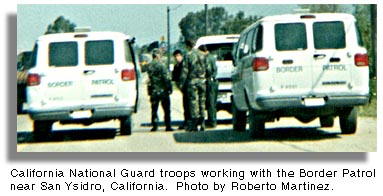Interview with Roberto Martinez (1997)
Immigration and Human Rights
on the U.S. / Mexico Border
Part 1: Militarization of the Border
San Diego, California
Roberto Martinez
is director of the U.S. / Mexico Border Program, an immigration law
enforcement monitoring project of the American Friends Service
Committee. In 1992, he became the first U.S. citizen to be honored as
an International Human Rights Monitor by the international human rights
organization Human Rights Watch. He has been a Chicano civil rights and
human rights activist for the past 20 years. This interview was
conducted in 1997 in San Diego by Nic Paget-Clarke.
Globalization
In Motion Magazine: Is there a relationship between immigration and the "globalization" of the world's economies?
 Roberto Martinez: Immigrant/refugee
rights groups across the country are now moving in the direction of
putting immigration in the context of a global economy, globalization,
people on the move escaping poverty, hunger, civil war, and
persecution. NAFTA (the North American Free Trade Agreement) kicked off
that trend. When we testified at the NAFTA hearings we complained of
why weren't they including immigration in the context of a financial
free trade agreement. Why were they focusing on the free movement of
merchandise but not on the free movement of people. Basically it's a
labor issue. Roberto Martinez: Immigrant/refugee
rights groups across the country are now moving in the direction of
putting immigration in the context of a global economy, globalization,
people on the move escaping poverty, hunger, civil war, and
persecution. NAFTA (the North American Free Trade Agreement) kicked off
that trend. When we testified at the NAFTA hearings we complained of
why weren't they including immigration in the context of a financial
free trade agreement. Why were they focusing on the free movement of
merchandise but not on the free movement of people. Basically it's a
labor issue.
California has always been impacted
tremendously by immigration, not just by people from Mexico, but also
by refugees and migrants from other countries. It's now estimated even
by the INS (Immigration and Naturalization Service) that there are at
least five million immigrants in the U.S. who are undocumented.
California usually comes in with at least half of those immigrants, not
only because of its juxtaposition to Baja California, but also it's a
place where people can blend into cities like L.A. and San Francisco.
There's about nine million in these cities and about a third are
immigrants and refugees.
It is important that we begin addressing immigration within the context
of a global economy. Globalization effects the United States because
investments in other countries have impacts such as people leaving that
country, the displacement of jobs, jobs moving in and out of a country.
Impacts on Human Rights / Militarization of the Border
 Roberto Martinez: Our
office primarily focuses on human rights and nowhere is human rights
more impacted than on the U.S.-Mexico border. These last few months
have really been a hateful time for us especially with the shooting by
the military of that 18-year-old, Ezequiel Hernandez, in Texas . Roberto Martinez: Our
office primarily focuses on human rights and nowhere is human rights
more impacted than on the U.S.-Mexico border. These last few months
have really been a hateful time for us especially with the shooting by
the military of that 18-year-old, Ezequiel Hernandez, in Texas .
Right after that, other military operations were exposed, including
here in California where National Guard troops have been out in
camouflage, hiding in the brush on the pretext of looking for drugs and
immigrants. In addition, Representative Jim Traficant (D- Ohio) has
introduced legislation in the House to send 10,000 military troops in
to California. This is in addition to 5,000 Border Patrol agents
approved by Congress in April of this year. That's going to interrupt a
lot of movement. It could eventually interfere with free trade because
how long will Mexico put up with this confrontation by the military on
the border.
For the first time since 1848, when the war with Mexico ended, we now
have U.S. troops face to face with Mexican troops on the border.
(Mexico has replaced its judicial police with Mexican troops.) There
have already been many incursions, confrontations.
In Motion Magazine: These troops are in uniform?
Roberto Martinez: In
uniform. Armed with M-16s. That's what they killed this boy with, an
M-16 in the back. A U.S. citizen. This the third shooting by the U.S.
military.
In 1992, they killed a day laborer crossing
from Nogales, crossing from Mexico into the U.S. When the three
laborers saw the U.S. troops they ran back towards Nogales and one of
them was shot in the back three times. In fact it wasn't even an M-16,
it was an AR-15. Many Border Patrol and National Guard troops are armed
with high-power military automatic weapons.
Every month we hold a protest and a press conference about this
increased militarization of the border. That's basically what this
issue is about right now. It's the militarization of the border.
In Motion Magazine: How formal is the presence of troops on the border? Are the troops stationed in bases?
Roberto Martinez: There
are bases in different areas. The JTF6 is based in Ft. Bliss, Texas, in
El Paso - most of them work out of there. The Green Berets are
operating in south Texas. And the National Guard are based out of
Orange County (California).
In Motion Magazine: So what do they physically do?
Roberto Martinez: Originally
the National Guard in California were supposed to supply back-up
support. for drug searches and seizures at ports-of-entry. But I have
taken pictures of them driving the Border Patrol vans and picking up
undocumented people along the border. I've not only witnessed it
several times but I've taken pictures of it. It came out in the L.A. Times
a week ago where a reporter uncovered a clandestine operation between
Mexicali and Yuma. There are maneuvers from San Diego to south Texas,
troops dressed in camouflage, wearing nets with twigs, painted faces,
back packs, M-16s and so on.
That's what's going on,
but people aren't aware of it. We, average people, our lives are in
danger when we come across troops accidentally while we're walking in
the hills. We aren't even aware of this. Like that kid. He did what he
did every day. He took his goats out to herd them, feed them. He
carried his .22 for target practice and to guard the goats against
animals. A team of Marines actually tracked him for a quarter of a
mile. Then they shot him. He didn't know they were there. They should
have known he was there because he did this every day, around six
o'clock. But they still tracked him, an 18-year-old high school student.
The investigating agency, law enforcement, said the evidence is totally
inconsistent with what the Marines are saying - such as the angle of
the bullet in the boy. They've already subpoenaed the general in charge
of that operation.
In Motion Magazine: That's was not the National Guard? It was the Marines?
Roberto Martinez: The U.S. Marines.
In Motion Magazine: What was the objective of that operation?
Roberto Martinez: Drugs.
According to the Marines, they were guarding the routes that drug
traffickers have been known to use from Mexico to the United States.
In Motion Magazine: So all of these operations' primary objective is drugs?
Roberto Martinez: Yes, but in the Traficant bill, they are very explicit that they also patrol the border for immigration as well as drugs.
Go to Part 2 - In Search of Work
- Jobs, Raids and the Mexican Economy
- Reforms
- Scapegoating
Published in In Motion Magazine September 14, 1997.
Also read:
|


 Part 1 - Militarization of the Border
Part 1 - Militarization of the Border

 Roberto Martinez: Our
office primarily focuses on human rights and nowhere is human rights
more impacted than on the U.S.-Mexico border. These last few months
have really been a hateful time for us especially with the shooting by
the military of that 18-year-old, Ezequiel Hernandez, in Texas .
Roberto Martinez: Our
office primarily focuses on human rights and nowhere is human rights
more impacted than on the U.S.-Mexico border. These last few months
have really been a hateful time for us especially with the shooting by
the military of that 18-year-old, Ezequiel Hernandez, in Texas .